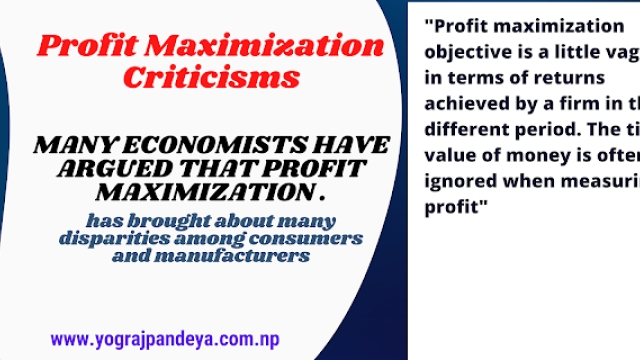Profit Maximization Criticisms
Many economists have argued that profit maximization has brought about many disparities among consumers and manufacturers.
Or
“Many economists contend that profit maximization has resulted in a widening gap between consumers and manufacturers“.
It may appear to be reasonable and a reward for efforts in ideal competition, but under imperfect competition, profit maximization should not be a firm’s primary goal.
When there was less rivalry in the past, selling and making commodities was essentially for mutual gain. Manufacturers didn’t manufacture for the sake of profit; instead, they produced for the common good and societal welfare. The sole producer’s goal was to maintain his market position by continuing to grow and creating a profit that would enable him keep his position.
In today’s world, however, the production system is dominated by a two-tier ownership and management structure. Ownership wants to maximize profit, whereas management attempts to control the production system, therefore boosting the business’s income indirectly.
Ownership wants to maximize profit, whereas management attempts to control the production system, therefore boosting the business’s income indirectly.
Customers consume these services, and as a result of the creation of cartels and monopolies, they are obliged to pay a higher price. Customers aren’t the only ones who have suffered; staff has as well. Employees are pushed to labor above their capabilities. They were forced to work longer hours for production to increase.
Many times manufacturers tend to produce goods that are of no use to society and create an artificial demand for the product through rigorous marketing and advertising. They make the goods so appealing to the buyer through packaging and labeling that it is tough for them to reject. This is most common with items aimed at children and teens. Ad advertisements and print advertising sometimes use inaccurate information to artificially inflate product expectations.
When there is an oligopoly and the nature of the product is similar, take advantage of the consumer to the fullest. They create cartels and influence pricing by limiting the consumer’s ability to bargain or pick among the items provided. In such a situation, the customer becomes the victim of these acts. The profit maximization motivation is always seeking to increase the firm’s income while placing less emphasis on societal welfare.
The government has a critical role to play in putting a stop to this practice of charging exorbitantly high rates for services or products. In reality, a market with a high level of competition is more likely to abuse customers in the name of profit maximization, whereas a market with restricted production of a specific product or service has a better opportunity to charge higher rates. When it comes to profit maximization, there are a few things that need to be clarified.
“Profit maximization objective is a little vague in terms of returns achieved by a firm in the different period. The time value of money is often ignored when measuring profit”
OR
“In terms of returns earned by a corporation over time, the profit maximization goal is a little hazy. When calculating profit, the time value of money is frequently overlooked.“
Returns are unpredictable as a result of this. Even if two companies employ the same technology and the same production parameters, their profits may differ in the long run. The profit margin is the reason behind this. If viewed from a different perspective, it may not be valid.
More:
- . Financial Goal – Profit vs Wealth
- 2. Capitalization in Finance
- 3. Capital Structure – Meaning and Factors Determining Capital Structure
- 4. Role of a Financial Manager
- 5. The Role of the Finance Function in Organizational Processes
- 6. Finance Functions
- 7. Financial Planning – Definition, Objectives, and Importance
- 8. Financial Management – Meaning, Objectives, and Functions


